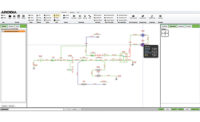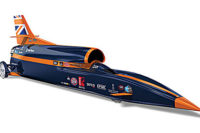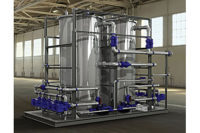To boost the energy output of wind turbines, manufacturers are developing taller structures with longer blades. That’s because the wind at 100 meters blows more steadily and 4.5 percent faster than it does at 80 meters, with an energy gain of about 14 percent. Longer blades can rotate more slowly, yet produce more electrical power. Last year, close to 5 percent of new turbines in the United States were 100 meters high, and the trend is expected to continue worldwide.
But bigger size brings with it significant engineering challenges. The weight of the turbine rotor and hub alone generate static radial load and pitching moments. Wind forces add static and dynamic axial loads on both the bearings and rotor blades. The wind also generates pitching and yawing moments that cycle with the position of the blades as they rotate. The effects of these forces can multiply as a wind turbine gets larger.
Given the significant costs involved in turbine construction, maintenance and repair, manufacturers must make certain the designs of newer, larger turbines are thoroughly proven ahead of time. That includes ensuring the bearings at the heart of every turbine will stand up to both structural and environmental stresses as long as possible, in every imaginable situation.
The industry has been using a variety of smaller test rigs to evaluate the performance of standard-size turbine bearings. But until recently there was no way to run real-world tests on the newer, larger bearings.
Enter Schaeffler Technologies AG & Co. in Herzogenaurach, Germany. The company’s catalog of more than 40,000 rolling bearing assemblies is one of the widest in the industry.
With years of experience in testing bearings, Schaeffler realized that the trend towards larger turbines would dictate a need for much bigger test rigs.
“Before even thinking about performing expensive real-world tests on large wind turbine bearings, we needed to quantify the critical operating conditions to minimize testing time and costs,” says Martin Stief, CAE integration department engineer for Schaeffler. “We also wanted this information to design and construct the best test rig possible for such large bearings.”
Finite element analysis (FEA) answered both needs.
Big Rigs for Big Bearings
While Schaeffler had small test rigs for simulating and applying real-world loads on small roller bearings, it did not have a rig big enough for a large wind turbine. “When planning our large rig project, conservative engineering was the watchword for extrapolating bearing lifetime tests from small to big bearings,” says Stief. “FEA helped us determine the lifetime of larger bearings more exactly. We can now design precisely the size of bearing required by a particular turbine geometry, which helps keep costs down. We were also able to do kinematic analysis with original parts, from both bearings and assemblies provided by customers. This saves on development time.”
The finished test rig is 16 meters long, 6 meters wide and 5.7 meters high. It weighs approximately 350 tons. As with wind turbines in the field, the rig is on a 5-degree tilt.
It has five main subassemblies: the drivetrain, loading frame, auxiliary bearing, test bearing and tensioning frame. Eight radial and axial cylinders replicate real-world loads. Approximately 500 bolts are needed to mount the auxiliary and test bearings. The finished rig can test bearings with a maximum diameter of approximately 3.5 meters, making it the most modern, largest, and highest performing bearing test rig in the world. At a cost of approximately $9.2 million, the rig represents a significant investment in Schaeffler’s future developments for the renewable energy and heavy equipment industries.
Despite the two years spent designing and constructing the test rig, the time spent on mechanical finite element (FE) simulation was short: just two months for strength assessment and modal analysis. “Because the wind industry is booming right now, we wanted to make the test rig as fast as possible,” says Stief. “This meant having a quick and accurate way to simulate, analyze, and verify rolling bearing assemblies—so we could create a test rig that could accurately measure them in action.”
Surmounting Design Challenges
Schaeffler started by creating a virtual prototype to validate the physical test rig, which itself would replicate the actual conditions for roller bearings in a wind turbine. To do this, Stief formed a simulation team of five full-time and two part-time members, all of whom were experienced with using Abaqus finite element analysis (FEA) software from Simulia.
The team divided the test rig analysis into smaller, manageable, functional FE submodels, which were then connected together to represent the overall test rig. To ensure the accuracy of this global representation, the team used its engineering judgment in defining loads, transition regions, and boundary conditions, such as stiffness, mass and damping, between FE submodels. Parts of the submodels were replaced by interface conditions that could be determined by analytical or simulation-based calculations. This approach helped reduce the size of the submodels and sped the creation of working models.
“We used Abaqus to test the strengths of joints and to check specific connections,” says Stief. “When the overall design of the test rig became clearer, we began using Abaqus on the submodels for strength verification. From those results, we improved the test-rig design using basic mechanical engineering know-how, such as strengthening ribs by making them larger. Then we’d run the submodel through Abaqus again for another strength assessment.”
The team also created an additional FE model to quickly evaluate the entire test rig’s modal behavior, as well as confirm their definitions for the boundary conditions between submodels. The modal analysis was also used to estimate the eigenfrequencies for the test rig. “Obviously, we don’t want resonance,” says Stief. “We don’t want the test rig shaking itself apart.”
Wind turbines typically rotate about 16 rpm, but the engineers wanted their test rig to run up to 60 rpm—the same as a critical excitation frequency of 1 hertz. The modal analysis confirmed that the first natural frequency of the rig was 13 hertz, well beyond this 1 hertz value and thus not an issue (subsequent frequencies were even higher).
To validate their virtual prototype, Schaeffler ran the full FE model of its test rig through a large number of load cases within Abaqus. Even with a very coarse mesh of the entire test rig, the load-case calculations initially hit the limits of the available computing capacity. Even with 32 gigabytes of RAM, calculating 17 load cases took 48 hours! However, this time was later slashed to 10 hours using a newly built-up high-performance computing cluster with faster CPUs and more RAM.
Software to the Rescue
Various functions within Abaqus helped make model creation efficient and fast. For example, Abaqus includes hundreds of types of user elements—subroutines that allow the engineers to define their own FE behavior inside an Abaqus model. In the bearing package submodel, the rolling elements of the bearings were replaced by customized user elements that represented the precise stiffness behavior of the rolling elements, as well as several degrees of freedom that would have had to be calculated separately. These special elements reduced the degrees of freedom by several orders of magnitude (from a range of 100,000 down to approximately 100). This significantly shortened the time, effort, and cost of 3D modeling and meshing each of the rolling elements. Computing time for analysis plummeted from about 5 hours to about 5 seconds.
“The large-bearing test rig has at least 500 of these rolling elements. It would have been impossible to make any FE calculations without user elements,” says Stief.
Other Abaqus functions helped facilitate stress analysis and strength verifications. The bolt modeling function, says Stief, proved “extremely useful because of the high number of bolts we preloaded with real-world values for stress and strain.” This function let the team create bolts, mesh them, and copy them as many times as needed in the 3D models. All subsequent copies were automatically meshed as well for FE analysis.
Geometry-based modeling helped the team quickly mesh variants of the whole model and numerous submodels. Scripting and other process automation techniques made modeling and evaluating the results easier and faster, greatly simplifying strength verification. Assembly, part and instance functionality promoted team collaboration, such as when exchanging parts between team members or replacing instances or parts where the design or FE properties had been changed.
With Abaqus’ options for abstraction, such as mass, stiffness and connectors, “We could reduce the size of the models by replacing large 3D structures with shell or beam structures, or by linking whole-model parts with the appropriate interface conditions,” says Stief.
Analysis Leads to Optimization
After stress analysis, the team focused on strength verification according to Germany’s FKM guideline for analytical strength assessment and the VDI 2230 standard for screw connections. The results pointed to additional design modifications in the test rig, such as optimizing screw connections, adding components for increased reliability, optimizing radii to reduce stresses, and adding reinforcing ribs.
“The simulation models we created proved our large-bearing test rig reliable and applicable for all types of large bearings,” says Stief. Going forward, simulation—validated with test rig runs—will also provide Schaeffler with bearing-specific values, such as load distribution, pressure distribution and contact angles, and important data about the elastic behavior of bearing components under high preload.
“This will lead to even more realistic results in bearing lifetime calculation,” says Stief.
Their current work now helps Schaeffler detect critical operating conditions early in the development of large bearings. It also minimizes test time on the rig. From this, Schaeffler can optimize bearing products earlier and easily in all the design stages and put added focus on reducing friction in its roller bearings.
Stief says that simulation with Abaqus FEA has been invaluable not just for maximizing the performance of Schaeffler’s products, but those of its customers. “In the wind industry, we can now develop more detailed instructions for operating and maintaining finished turbines,” he says. “This, in turn, helps us provide our customers with more precise recommendations about the construction of their wind turbines.”
How FEA Works
Finite element analysis (FEA) is a widely accepted computer simulation methodology for modeling, evaluating and optimizing a product’s mechanical and structural design. The technology has a long history of effective use within the energy, aerospace and automotive industries and is now being applied more widely in consumer goods, medical devices and other sectors.
Engineers generally start with a CAD model—perhaps of an airfoil, a piping component for a nuclear plant, or the blade of a wind turbine—and then use FEA software to transform that model into a 3D mesh of geometric units. These are the “elements” in finite element analysis. Each element is assigned a distinct size and shape mathematically representing a finite section of the model. Linked together by nodes that quantify their interrelationship, the elements (which can number in the hundreds of thousands or even millions) are further constrained by boundary conditions, material characteristics, and a host of other inputs dictated by what type of product or structure is being modeled.
Once an FEA model is set up, any number of static, dynamic, linear or nonlinear events, including contact, collisions, buckling or collapse scenarios, can be simulated and analyzed. Even multiphysics analyses, such as thermal-structural, fluid structure interaction or computational fluid dynamics, can be simulated. Feedback from the FEA solution (“virtual testing”) is then used to evaluate and modify the CAD design, repeatedly if necessary, until the desired product functionality and durability are reached.
The results of FEA are typically verified with real-world tests. However, when used in conjunction with historical engineering test data, FEA can reduce design time as well as the expense of extensive physical prototyping.









